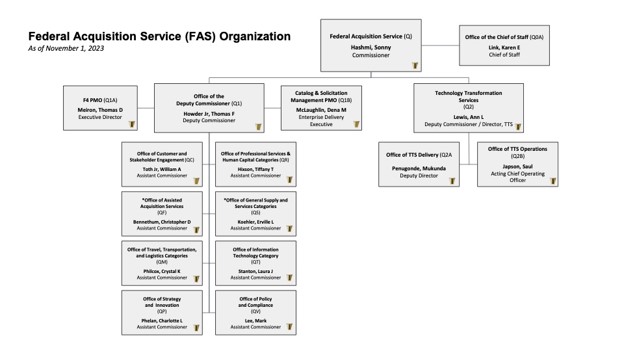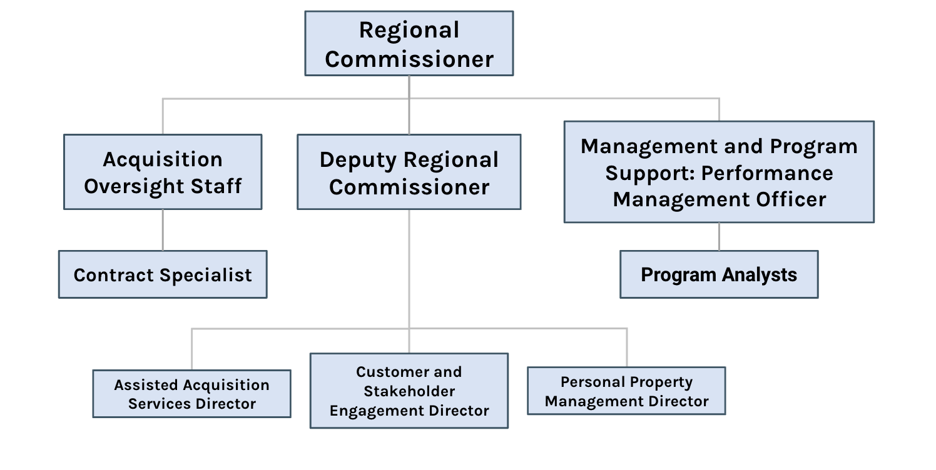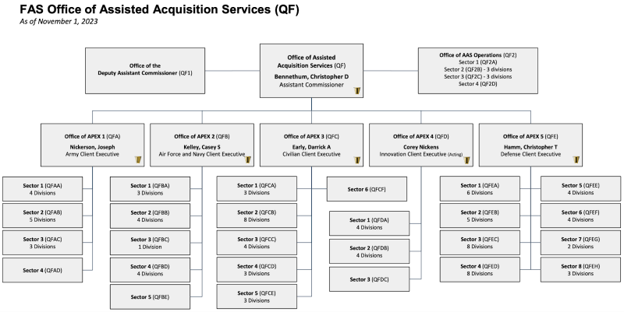The General Services Administration (GSA) has made several significant announcements recently, mainly related to the Federal Acquisition Service (FAS). FAS is restructuring itself to streamline its acquisition processes and improve customer service. Beyond FAS, GSA is also making numerous fundamental personnel changes. Read on to see what those changes are and how impactful these changes are to the federal contracting industry.
Background
First, let’s quickly review how entrenched FAS is in the entire acquisition ecosystem.
In FY22, FAS helped government agencies navigate their 31M offerings and acquire $87.5B in goods and services. As the federal government’s purchasing agent, GSA, primarily through FAS, connects federal purchasers with commercial products and services. FAS uses the collective buying power of the government to assist other agencies, playing a crucial role in executing much of the federal government’s mission by shaping the acquisition of critical products and services that directly impact the American public.
Since FAS is involved in so much of the federal acquisition process, its operations and success are crucial for the current administration and the government contracting ecosystem. Furthermore, they assist state, local, and tribal governments in overhauling and reshaping vital needs and systems like disaster purchasing to student debt relief – touching virtually every corner of the United States.
In GSA’s FY23 Congressional Justification, FAS seeks to consolidate its acquisition vehicles to improve the federal marketplace. The Federal Marketplace (FMP) Strategy is GSA’s plan to modernize the buying and selling experience for customers, suppliers, and acquisition professionals alike. It began as four projects:
- MAS Consolidations
- Catalog Management
- Commercial Platforms
- Contract Acquisition Life-cycle Management (CALM) system
Some of FMP’s recent improvements include updating the MAS Roadmap to include instructions and templates for prospective suppliers looking to get on GSA schedules; adding a checklist and self-help modules for buyers building an acquisition package; offering an online application for the VPP; and adding status indicators on GSA Advantage to let customers know if a product has limited or no stock in place of supply chain disruptions. Now, FAS is taking more substantial action.
Significant Changes for FAS in 2024
FY24 will be a crucial year for FAS as it shifts from its regional structure to a functional customer support team structure where major organizations within FAS, including the Assisted Acquisition Service (AAS) and the Office of Customer and Stakeholder Engagement (CASE), are re-aligned to customer segments to simplify customer interactions.
The logic in taking disparate regional offices that support the same federal customer, such as the U.S. Air Force, and consolidating them into one is that FAS now has a single unit working in unison over a shared purpose (i.e., the U.S. Air Force). Furthermore, this change will allow federal employees looking for new opportunities within FAS to expand beyond their geographical region, resulting in more flexible staffing and capacity planning.
Overall, initial reactions to the reorganization have been generally positive, as FAS, in theory, should increase specialization, efficiency, and accountability with these realignments.
What does this all look like?
Here is the new organizational structure. The organization of the Office of Technology Transformation Services (TTS), CASE, and more can be found here.

Look at the old organizational flow chart for a FAS Regional Office below for reference. One significant change is that, whereas the Deputy Commissioner used to oversee only three positions, there are now six new offices.
Some new offices focus on FAS’ overall acquisition, such as the Offices of Policy and Compliance and Enterprise Strategy Management. At the same time, some are specific to a category of goods or services, like the Offices of Professional Services & Human Capital and Information Technology Category.

Of note, FEDSIM, previously located within AAS, has been dissolved into five AAS Client-Based Acquisition & Procurement Centers of Excellent, or APEX.
- Army
- Air Force & Navy
- Civilian
- Innovation
- Defense
For those unfamiliar, FEDSIM serves as the only full-service, government-wide assisted acquisition organization that provides hands-on strategic direction and development throughout all phases of the acquisition process. In FY23, FEDSIM served as the contract authority for over 22 competitive contract awards totaling $10.4B in total obligations.
As FEDSIM’s portfolio and competition pool continue to increase every fiscal year, you can bet that this adjustment will significantly impact how federal agencies receive FAS support.

The five APEXes will be led by Client Executives responsible for resource allocation within their division. FAS hopes to balance this with a certain level of stability, too, understanding that acquisition goes more smoothly when a contracting office is familiar with the entire history of a contract, including its buyer, end-user, and requirements.
Personnel Changes Across GSA
At FAS, there are some familiar faces with new roles. And some changes together.
Most recently, this month, Sonny Hashmi, the former FAS Commissioner, announced that he was leaving GSA for the private sector. Tom Howder, the former Deputy Commissioner, will act as Commissioner until a permanent replacement is made.
This move follows a five FAS Senior Executives change from earlier in 2022 and 2023. While such moves are standard, concerns about the impacts on employees and customers were expressed. The shifts were:
- Erv Koehler went from CASE to Head of the Office of General Supplies and Services (GS&S).
- Bill Toth went from Director of the Office of Fleet Management to Assistant Commissioner of CASE.
- Charlotte Phelan went from the Office of Travel, Transportation, and Logistics (TTL) to the Head of the Office of Enterprise Strategy Management (QP).
- Crystal Philcox went from QP to the Head of TTL.
- Bob Noogan went from Head of GS&S to Senior Advisor for Workplace Programs.
Critical changes are not just limited to FAS, either.
Public Buildings Service’s (PBS) Commissioner, Nina Albert, stepped down and would be replaced by the Regional Administrator for GSA’s National Capital Region, Elliot Doomes.
Raylene Yung, GSA’s Executive Director of the Technology Modernization Fund (TMF) Program Management Office (PMO), also parted ways with the agency at the end of October. There is no permanent replacement, and the Customer Experience Portfolio Manager Director for TMF PMO, Jessie Posilkin, will serve as the Acting Director in the interim.
The need for a permanent Director is concerning, given how important the TMF has become in recent years, coupled with the reorganization within FAS. Pushing the envelope even further, the proposed Modernizing Government Technology (MGT) Reform Act would adjust investment repayment rules to be more transparent and extend the TMF Board an additional five years to 2030.
While this reform is not as drastic as other changes, it still refocuses on TMF’s purpose. GSA would also receive operational funding from agencies until December 2030, so they have skin in the game. Clear roles and responsibilities are crucial in times like these, which may be clouded by Directors coming and going.
All of these leaders will be instrumental in the reorganization. People come and go, and GSA must refrain from forcing people to stay due to its reorganizations. But we cannot help but be reminded of GSA’s belief that longtime employees who understand the background are strengths in a transition.
Acquisition Continues
At the end of October, GSA released a draft RFQ for its Supply Chain Risk Illumination Professional Tools and Services (SCRIPTS) Blanket Purchase Agreement (BPA). SCRIPTS is a ten-year, multiple-award vehicle on GSA’s Multiple Award Schedules (MAS). The Contracting Office is listed as FAS AAS Region 4, but this may change with the restructure.
Another program of concern is the Research, Innovation, and Outcomes (RIO) vehicle. RIO, led by FEDSIM’s IDIQ Labs, aims to bridge the “valley of death” between early prototyping of new technology and getting it into the hands of government users. While a Request for Information (RFI) was released in February 2023, the industry has not seen any additional movement on this proposed contract. It is unclear how the FEDSIM re-alignment will impact this much-anticipated solution or if it will be lost entirely in the shuffle.
Not surprisingly, the changes will also affect GSA’s Federal Supply Schedule (FSS) program. The FSS regional contracting methods are being realigned into three categories: the Office of Information Technology (OIT), the Office of Professional Services and Human Capital (PSHC), and GS&S. The GSA and FAS leadership hopes that this adjustment will improve FSS acquisition workforce professional development, workload management, and contract administration.
Our Thoughts and Analysis
This restructuring is coming when FAS and the federal government spend more money than ever, increasing the complexity of government-wide acquisition and the burden on procurement and contracting offices. Additionally, this reorganization was planned to start in October at the beginning of the new fiscal year, but uncertainties in an FY24 budget may complicate or even delay progress.
Leadership upheaval happening simultaneously as an overall reorganization does not bode well for effective communication and clarity in the coming months as everyone settles into new routines and chains of command.
GSA states it will be a smooth transition for customers and industry partners, but do we believe it? Think back to other significant acquisition-related changes.
Was the UEI transition seamless?
What about new COI restrictions?
The shift from Alliant 2 to Polaris?
Moving from FPDS to SAM?
Our short answer: no, we don’t believe this will be smooth with little impact.
GSA expects hundreds of new leadership and frontline management positions to open; in October alone, 40 became available. This gap is especially alarming considering the staffing and training problems the government’s acquisition workforce faces.
FAS promises a more efficient and positive overall experience from this significant reorganization but also promises no major changes in the day-to-day operations of its employees. How these so-called significant changes will come about without actually making major changes is beyond us. We agree with FAS, however, that communication between executives and their employees, and employees and customers, will be the determining factors in the success of this reorganization.
Researched and authored by Haley Boulanger, Pulse Analyst.
